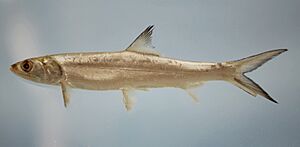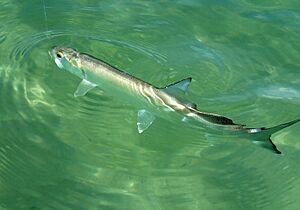Elops saurus facts for kids
Quick facts for kids Elops saurus |
|
|---|---|
 |
|
| Conservation status | |
| Scientific classification | |
| Synonyms | |
|
The ladyfish or tenpounder (Elops saurus) is a cool fish that lives in the ocean. It's the only type of fish in its group, called Elops, which is part of a unique fish family called Elopidae.
Contents
What Does a Ladyfish Look Like?
Ladyfish have a long, thin, and rounded body. It's covered with shiny, silver scales, making them look very sleek. Their mouth is at the very front of their head. Their tail is shaped like a deep "V". Scientists can tell different types of ladyfish apart. They do this by counting tiny parts in their gills and the bones in their backbone.
Where Do Ladyfish Live?
You can find ladyfish in the western part of the Atlantic Ocean. They swim from places like New England all the way down to Florida. They also live in the Gulf of Mexico. Sometimes, they share their home with another similar fish called the malacho (Elops smithi). This happens in the southeastern United States and the southern Gulf of Mexico.
The Amazing Life Cycle of a Ladyfish
Ladyfish are pelagic fish. This means they love to live in the open ocean, far from the coast. They lay their eggs in the sea, but scientists don't know much about this part of their life.
From Larva to Juvenile
When ladyfish first hatch, they are called larvae. These larvae are clear and flat. Ocean currents carry them closer to shore. They then swim into bays and other sheltered water areas. They live there for about two to three years.
Growing Up in Different Waters
Young ladyfish are very special because they are euryhaline. This means they can handle many different levels of saltiness in the water. So, the bays they live in might be estuaries with low salt levels. Or, they could be very salty lagoons, called hypersaline lagoons. As they grow bigger, they move to the deeper parts of these bays. When they become adults, they swim out to the open ocean.
What Challenges Do Ladyfish Face?
Ladyfish use bays and salty lagoons as their homes when they are young. Changes to these important habitats can affect how many ladyfish there are. Even though ladyfish can live in many places, they can still be harmed. Things like building new homes and cities near the coast can cause problems for their habitats.



